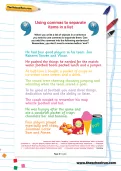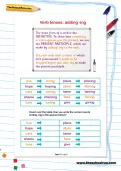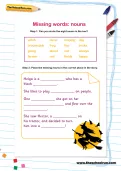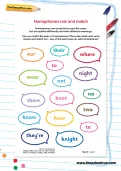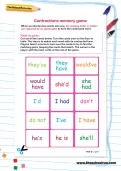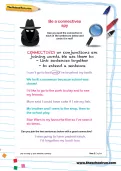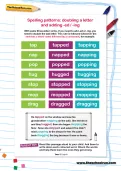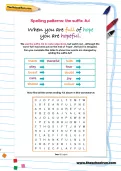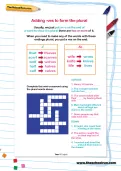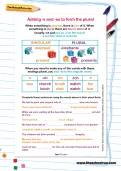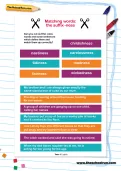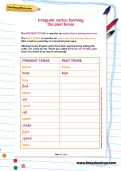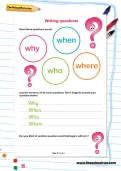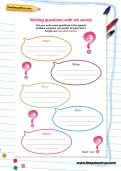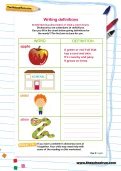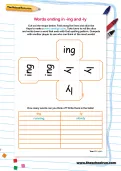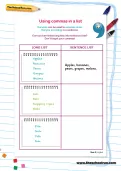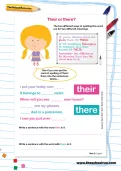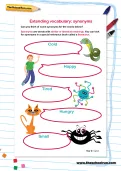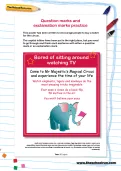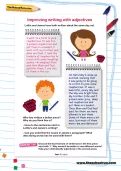Homophones are words that sound the same but are spelled differently and have different meanings. Can you match the pairs of homophones? Describe what each word means and watch out – two of the pairs have an extra homophone!
or
Register to add to your saved resources
Already a subscriber? to view this content.
When we shorten two words into one, the missing letter or letters are replaced by an apostrophe to form the contracted word. Practise matching words with their contracted form with this contractions memory game.
or
Register to add to your saved resources
Already a subscriber? to view this content.
Connectives or conjunctions are joining words. Can you spot the connective in each of the sentences below and circle it in red?
or
Register to add to your saved resources
A SUFFIX is a word ending, added to a ‘root’ word to change it into another word. Can you change these words by adding a suffix (and changing the root word if needed)?
or
Register to add to your saved resources
Already a subscriber? to view this content.
With some three-letter verbs, if you need to add -ed or -ing, you need to double the last letter. This rule is followed whenever the verb has a short vowel followed by a consonant. Read this passage aloud, then write down each coloured word. Check the words and then learn to spell any you get wrong.
or
Register to add to your saved resources
Already a subscriber? to view this content.
This is a KS1 English worksheet on verb tenses ending in -ing, created by a primary-school teacher to help your child learn at home.
or
Register to add to your saved resources
We use the suffix -ful to make adjectives, but watch out – although the word ‘full’ has been put on the end of ‘hope’, the last l is dropped. Can you complete this table to show how words are changed by adding the suffix-ful? Then find all the words ending -ful above in this wordsearch.
or
Register to add to your saved resources
Already a subscriber? to view this content.
Can you complete this fun mini-crossword with the plurals of these words? Be careful though – you can't just add -s to these words like you normally would to make a word plural.
or
Register to add to your saved resources
When something is singular, there is one of it. When something is plural there are two or more of it. Usually, we just put an -s on the end of a word to show it is plural. But to make some words plural we need to add -es to the singular word. Can you complete these sentences using the words above in their plural form?
or
Register to add to your saved resources
Already a subscriber? to view this content.
Can you cut out the -ness words and some sentences which define them and match them up correctly?
or
Register to add to your saved resources
Already a subscriber? to view this content.
A Year 2 irregular verbs worksheet focusing on forming the past tense. This KS1 activity was created by an experienced teacher to help your child practise what they will be learning at school.
or
Register to add to your saved resources
Already a subscriber? to view this content.
Read these questions words then use the words to write some questions. Don’t forget to include your question marks!
or
Register to add to your saved resources
Already a subscriber? to view this content.
Can you write some questions in the speech bubbles using the ‘wh words’ to help? Don’t forget your question marks!
or
Register to add to your saved resources
Already a subscriber? to view this content.
A definition is a description of what a word means. Dictionaries are collections of definitions. Can you fill in the chart giving definitions for the words? The first one is done for you.
or
Register to add to your saved resources
Already a subscriber? to view this content.
Cut out the shape below. Fold along the lines and stick the flaps to make a word endings cube. Take turns to roll the dice and write down a word that ends with that spelling pattern. Compete with another player to see who can think of the most words! How many words can you think of? Write them in the table!
or
Register to add to your saved resources
Already a subscriber? to view this content.
Commas can be used to separate items that you are listing in a sentence. Can you turn these long lists into sentence lists? Don’t forget your commas!
or
Register to add to your saved resources
Already a subscriber? to view this content.
The two different ways of spelling this word are for two different meanings. If you’re talking about the place there it’s THERE. If it’s something belonging to someone (e.g. their house) it’s THEIR. Remember the difference by thinking there has the word 'here' in it. See if you can put the correct spelling of their/ there into these sentences.
or
Register to add to your saved resources
Already a subscriber? to view this content.
Can you think of some synonyms for these words? Synonyms are words with similar or identical meanings. You can look for synonyms in a special reference book called a thesaurus.
or
Register to add to your saved resources
Already a subscriber? to view this content.
This poster has been written to encourage people to buy a ticket for the circus. The capital letters have been put in the right place, but you need to go through and finish each sentence with either a question mark or an exclamation mark.
or
Register to add to your saved resources
Already a subscriber? to view this content.
Lottie and James have both written about the same day out. Who has written a better piece? Why do you think this is? How do the sentences start in Lottie’s and James’s writing? Can you underline the nouns in James’s paragraph? What describing words has he used with them?
or
Register to add to your saved resources
Already a subscriber? to view this content.
